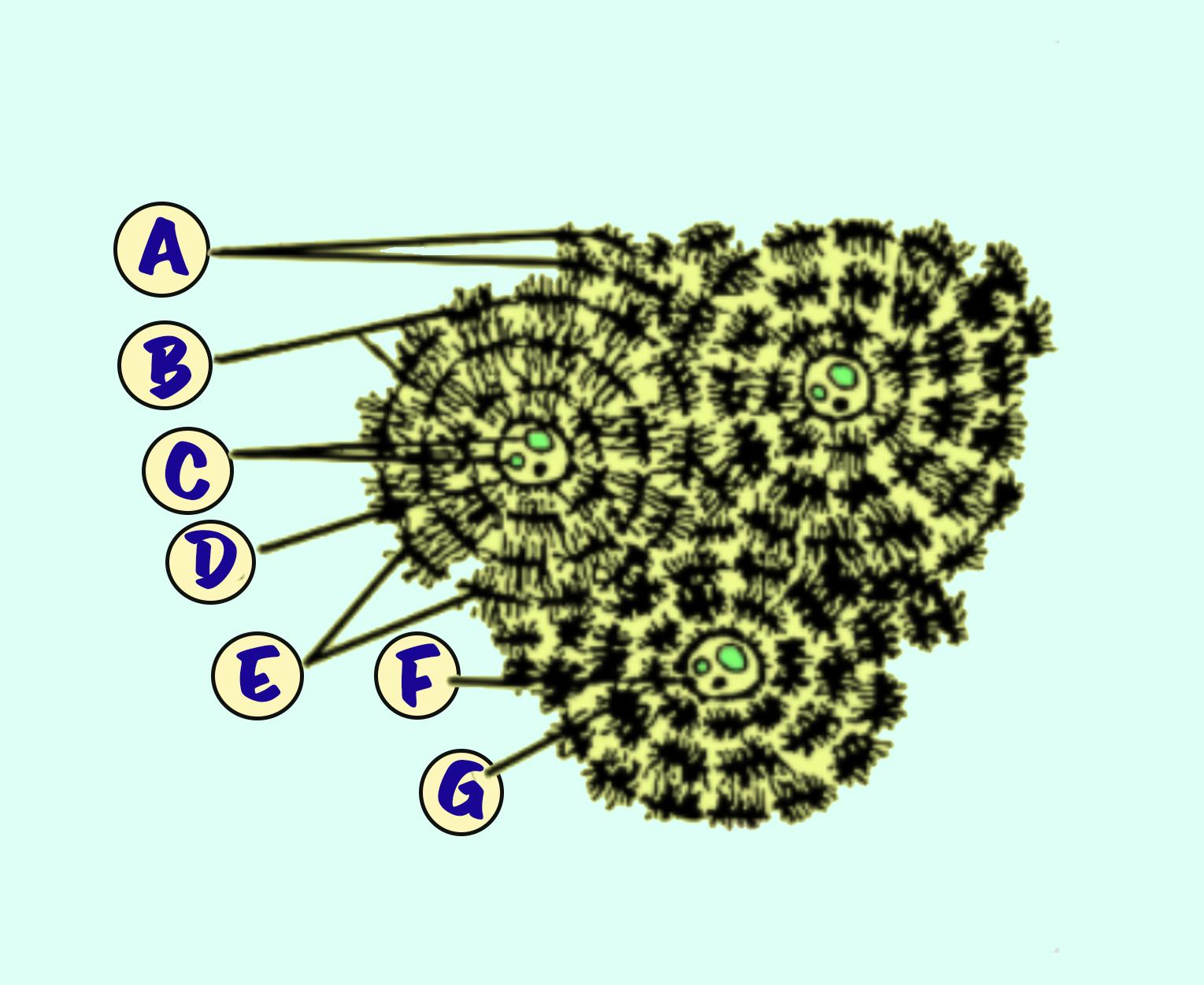
In the diagram of the section of bone tissue given above, certain parts have been indicated by the alphabets. Choose the answer in which these alphabets have been correctly matched with the parts which they indicate.

(a)A=Interstitial lamellae, B=Laemae with osteocytes, C=Blood vessels, D=Nerve, E=Canaliculi, F=Haversian canal, G=Lamellae
(b)A=Interstitial lamellae, B=Osteocytes in the lacunae, C=Blood vessels, D=Nerve, E=Lamellae, F=Haversian system, G=Canaliculi
(c)A=Interstitial lamellae, B=Osteocytes, C=Nerve, D=Blood vessels, E=Canaliculi, F=Haversian system, G=Lamellae
(d)A=Interstitial lamellae, B=Osteocytes, C=Nerve, D=Blood vessel, E=Lamellae, F=Haversian canal, G=Canaliculi

Answer
548.4k+ views
Hint: Bone is a type of specialized connective tissue that forms the structural framework of the body, movements, and weight-bearing functions. The bone mostly consists of an extracellular matrix arranged in the form of lamellae which is secreted by osteoblasts.
Complete Answer:
The structure of bone is divided into the spongy bone and compact bone. The compact bone consists of a matrix secreted by the osteoblasts arranged in the form of Lamellae. When the osteoblasts are depositing the lamellae they enclose themselves in hollow cavities known as Lacunae as shown by ‘B’. The lamellae are arranged parallel to each other and present in concentric circles around larger longitudinal canals known as the Haversian canals as shown by ‘E’ in the figure. The Haversian canals along with their surrounding lamellae are known as Haversian systems or osteons as shown by ‘F’. The Haversian canal consists of blood vessels and nerves as shown by ‘C’ and ‘D’ respectively. There are some lamellae that are not associated with any Haversian system and are present in the interstitial space between two Haversian systems known as interstitial lamellae as shown by ‘A’. There are small channels present within this matrix known as Canaliculi that provide a means of communication and the exchange of substances between different osteocytes as shown by ‘G’.
So, the correct option is ‘A=Interstitial lamellae, B=Osteocytes in the lacunae, C=Blood vessels, D=Nerve, E=Lamellae, F=Haversian system, G=Canaliculi’.
Note:
-Connective tissues are the tissues responsible for linking and supporting different tissues/organs of the body. They are further divided into loose connective tissue, dense connective tissue, and specialized connective tissue.
-Connective tissues generally contain cells that secrete fibers of structural proteins like collagen or elastin. These fibers are responsible for providing strength, elasticity, and flexibility to the tissue.
-Loose connective tissue includes adipose and areolar tissue, dense connective tissue includes tendons and ligaments whereas specialized connective tissue includes cartilage, bones, and blood.
Complete Answer:
The structure of bone is divided into the spongy bone and compact bone. The compact bone consists of a matrix secreted by the osteoblasts arranged in the form of Lamellae. When the osteoblasts are depositing the lamellae they enclose themselves in hollow cavities known as Lacunae as shown by ‘B’. The lamellae are arranged parallel to each other and present in concentric circles around larger longitudinal canals known as the Haversian canals as shown by ‘E’ in the figure. The Haversian canals along with their surrounding lamellae are known as Haversian systems or osteons as shown by ‘F’. The Haversian canal consists of blood vessels and nerves as shown by ‘C’ and ‘D’ respectively. There are some lamellae that are not associated with any Haversian system and are present in the interstitial space between two Haversian systems known as interstitial lamellae as shown by ‘A’. There are small channels present within this matrix known as Canaliculi that provide a means of communication and the exchange of substances between different osteocytes as shown by ‘G’.
So, the correct option is ‘A=Interstitial lamellae, B=Osteocytes in the lacunae, C=Blood vessels, D=Nerve, E=Lamellae, F=Haversian system, G=Canaliculi’.
Note:
-Connective tissues are the tissues responsible for linking and supporting different tissues/organs of the body. They are further divided into loose connective tissue, dense connective tissue, and specialized connective tissue.
-Connective tissues generally contain cells that secrete fibers of structural proteins like collagen or elastin. These fibers are responsible for providing strength, elasticity, and flexibility to the tissue.
-Loose connective tissue includes adipose and areolar tissue, dense connective tissue includes tendons and ligaments whereas specialized connective tissue includes cartilage, bones, and blood.
Recently Updated Pages
Why are manures considered better than fertilizers class 11 biology CBSE

Find the coordinates of the midpoint of the line segment class 11 maths CBSE

Distinguish between static friction limiting friction class 11 physics CBSE

The Chairman of the constituent Assembly was A Jawaharlal class 11 social science CBSE

The first National Commission on Labour NCL submitted class 11 social science CBSE

Number of all subshell of n + l 7 is A 4 B 5 C 6 D class 11 chemistry CBSE

Trending doubts
Differentiate between an exothermic and an endothermic class 11 chemistry CBSE

10 examples of friction in our daily life

One Metric ton is equal to kg A 10000 B 1000 C 100 class 11 physics CBSE

Difference Between Prokaryotic Cells and Eukaryotic Cells

1 Quintal is equal to a 110 kg b 10 kg c 100kg d 1000 class 11 physics CBSE

State the laws of reflection of light




